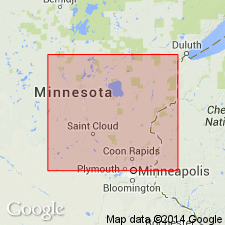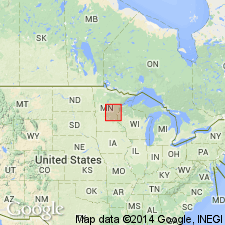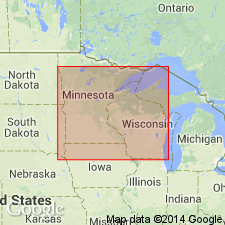
- Usage in publication:
-
- McGrath gneiss
- Modifications:
-
- First used
- Dominant lithology:
-
- Gneiss
- AAPG geologic province:
-
- Lake Superior region
Summary:
First use of name McGrath gneiss--however, originally defined as McGrath haligranite augen gneiss in student thesis by Skillman (1946). Present in central MN in the Lake Superior region mostly east of Mille Lacs Lake. Largest exposures of augen gneiss are 2 mi southwest of McGrath. Other exposures are near Dads Corner, Arthyde, and Denham. Penetrates Thomson formation "let-par-let". Well foliated, containing pink and black alternating biotite- and hornblende-rich bands. Was metamorphosed prior to late Algoman intrusive event. Possibly succeeded by unnamed early Algoman actinolite gabbro. Petrographic description; stratigraphic succession; generalized geologic map. Is early Algoman in age.
Source: GNU records (USGS DDS-6; Denver GNULEX).

- Usage in publication:
-
- McGrath Gneiss
- Modifications:
-
- Overview
- Areal extent
- Dominant lithology:
-
- Gneiss
- AAPG geologic province:
-
- Lake Superior region
Summary:
Refers to pink quartzose feldspathic gneiss that sporadically crops out in an east-trending belt about 30 km wide from east side of Mille Lacs Lake to near Denham, east-central MN in Lake Superior region. Type locality designated for typical exposures in sec 17, T43N, R24W, 3 km southwest of village of McGrath, Aitkin Co. Other good exposures in Pine Co--1) near Denham in secs 25 and 28, T45N, R21W; 2) along Bremen Creek in E 1/2 sec 19 and sec 20, T44N, R21W; and 3) along a low ridge in SW1/4 sec 16, T44N, R21W. Is also well exposed in abandoned quarry 3.5 km west of Dads Corner in NW1/4 NW1/4 sec 6, T44N, R23W. Although known outcrops are sparsely distributed, geophysical data indicate unit underlies extensive area where it forms several broad, dome-shaped, anticlinoria bounded and locally overlain by middle Precambrian strata. Is medium- or coarse-grained, locally migmatitic, pinkish-gray, biotite-bearing quartzose feldspathic gneiss with large microcline crystals. Mineralogy and texture variable due to local cataclasis. Uncataclastized rocks yield isotopic age of at least 2,700 m.y., or early Precambrian. Petrologic description; geologic map.
Source: GNU records (USGS DDS-6; Denver GNULEX).

- Usage in publication:
-
- McGrath Gneiss*
- Modifications:
-
- Overview
- AAPG geologic province:
-
- Lake Superior region
Summary:
Present in east-central MN in the Lake Superior region. Is a coarse-grained, locally migmatitic augen gneiss of quartz monzonitic composition. Forms several gneiss domes surrounded by younger metamorphic rocks. Correlation chart. Is of Middle? or Late Archean age.
Source: GNU records (USGS DDS-6; Denver GNULEX).
For more information, please contact Nancy Stamm, Geologic Names Committee Secretary.
Asterisk (*) indicates published by U.S. Geological Survey authors.
"No current usage" (†) implies that a name has been abandoned or has fallen into disuse. Former usage and, if known, replacement name given in parentheses ( ).
Slash (/) indicates name conflicts with nomenclatural guidelines (CSN, 1933; ACSN, 1961, 1970; NACSN, 1983, 2005, 2021). May be explained within brackets ([ ]).

